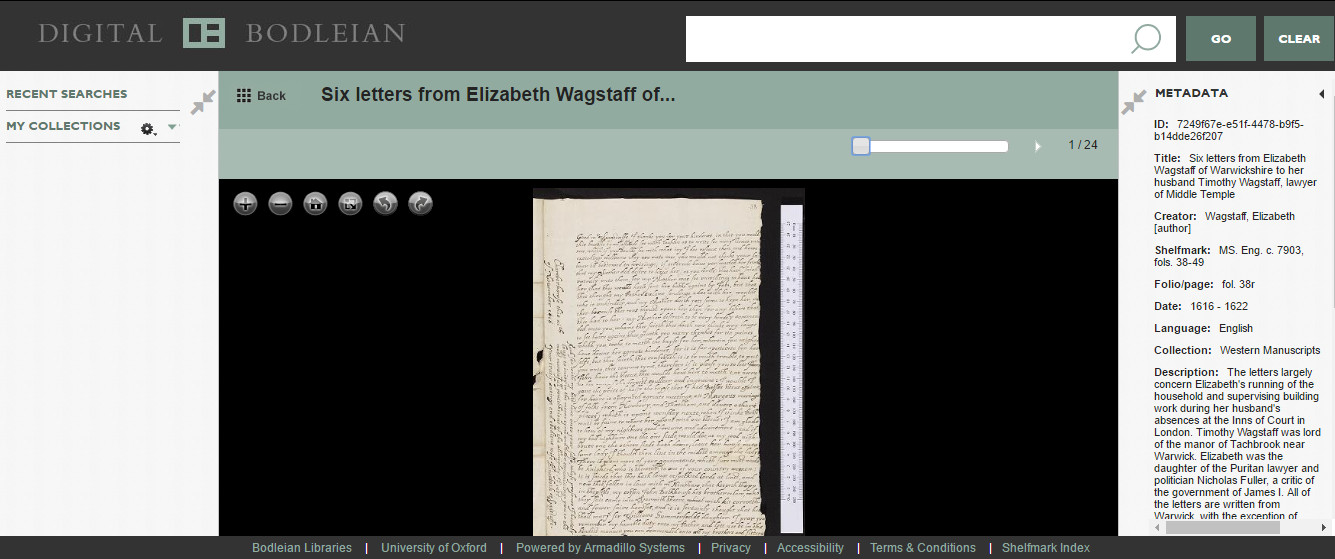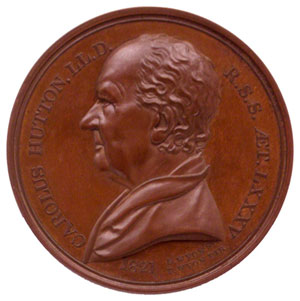This productive year has seen publication in EMLO of thirty-one new correspondence catalogues, significant enhancements to an existing dozen (either with new letters, further detailed metadata, or transcriptions added), and the blossoming of a number of ground-breaking initiatives, including of course the pioneering and rapidly taken up Bodleian Student Editions. Summer was heralded this year with the official launch in Oxford of Women’s Early Modern Letters Online [WEMLO], the invaluable resource and networking hub for scholars of women’s correspondence, and we were truly thrilled that this was followed by a spectacular autumn launch at the Royal Palace in Amsterdam of the correspondences of the wives of the seventeenth-century Dutch Stadtholders, compiled by Dr Ineke Huysman. And now, in these dwindling December days, EMLO sees out this year with the correspondence of one of the sixteenth-century’s most remarkable figures, Bess of Hardwick.

Bess was an indomitable woman. Widely known for four fortuitous marriages, each layering status and wealth onto the foundations of the previous, her life played out against a backdrop of England’s religious troubles under a succession of Tudor monarchs (Henry VII, Edward, Mary, and Elizabeth) until, by the time she died at the age of about 87, the first Stuart king James VI and I was well into his reign over a combined Scotland and England. This longevity enabled Bess to plan and to build in a number of ways. She weathered her childbearing years to emerge as a matriarch and a builder of dynasties. With her second husband, the twice-widowed treasurer of the king’s chamber Sir William Cavendish, she bore eight children, six of whom survived to adulthood. In addition, Bess presided over a dizzying number of step-children as well as her grand- and step-grandchildren (I’m not going to attempt to count them but, rather, leave this figure open as a new year’s quiz; answers by email only, please!). Marriages were orchestrated carefully, even between her own children and her step-children, and from 1582 she was responsible for raising her granddaughter, Arbella Stuart (1575–1615), a claimant — as the child of Bess’s own daughter, Elizabeth Cavendish, and Charles Stuart — to both the English and the Scottish crowns in the years when the aging Queen Elizabeth refused to name a successor. It may have been a wise decision that, as a begetter of heirs, Bess kept herself largely to her home county of Derbyshire, despite being entreated by none less than the lord treasurer himself, William Cecil, Lord Burghley, not to ‘not live so solitary as it seems you do there in Chatsworth amongst hills and rocks of stones’.
But what stones, because, of course, Bess was also a builder in bricks and mortar (and glass!) as the creator of a succession of exceptionally impressive and architecturally striking houses. She was born into Derbyshire gentry, but on her father’s death in 1528 his modest property around Hardwick was seized and administered by the office of wards until his son and heir, Bess’s brother James, came of age. Bess’s mother, Elizabeth Leeke, remarried Ralph Leche of Chatsworth, although the union brought little by way of money or land. It was Bess’s second marriage to Sir William Cavendish, who just about weathered the complicated years of both Edward VI and Mary I, that enabled the purchase — in the couple’s name jointly — of the Chatsworth lands from the Bess’s step-family, the Leches, and thereafter the building of Chatsworth House, an architectural project Bess focussed upon well into the 1560s even though her husband William died in 1557. (If you follow this link, you’ll find an exquisite needlework image of the west front of the Chatsworth Bess built.)
It was some two decades later, however, in 1587, following an acrimonious legal battle over estates with her fourth husband, George Talbot (sixth earl of Shrewsbury, and keeper between 1568 and 1584 of Mary, Queen of Scots), that Bess embarked upon her most creative enterprises. In 1583, in the name of her son William, she had purchased the Hardwick lands following the death of her brother James, who had ended his days a bankrupt two years previously in Fleet Prison leaving just one — illegitimate — son. (The correspondence contains a letter from James to Bess asking for money, as well as another from their mother writing on his behalf with the same request.) Within just eight years, the house known today as ‘Hardwick Old Hall’ was complete, and by 1599 the monumental ‘Hardwick New Hall’, one of the most architecturally ambitious and audacious undertakings of the age, was in place. This house, for which even the rigorous Pevsner rolls out the rhyme ‘Hardwick Hall, more window than wall’, is topped with stone-carved crowns and Bess’s own monogram ‘ES’ [Elizabeth Shrewsbury].
Bess’s correspondence charts these remarkable creations as well as her own extraordinary story and it affords us detailed glimpses into her world of building and family management as she navigated the complexities of the times in which she lived, exchanging letters with royalty and figures of state, with family, friends, and servants alike. Her letters — currently 234 in total — have been edited and published together with full transcripts, commentaries, and images of many of the manuscripts by the AHRC-funded project Bess of Hardwick’s Letters: The Complete Correspondence (University of Glasgow), under the direction of Dr Alison Wiggins, and each record in the EMLO catalogue links straight through to this project’s full entry.
We hope you will take advantage of the midwinter break to explore Bess’s correspondence, and to set it against those of her contemporaries in EMLO, both male and female. 2016 will long be remembered by us as the year in which WEMLO was launched, and with 12,285 letter records currently in the union catalogue from, to, or mentioning women, we look forward greatly to the quantity of women’s correspondence increasing apace over the year ahead. To echo the words of our colleague Dr Kim McLean-Fiander, co-director with Professor James Daybell of WEMLO, a gender search is something that should be built into all digital correspondence editions and library catalogues, for both women and men need to be searchable by gender as well as across the combined whole. Whatever your search and whichever correspondence you intend to consult, we hope you find this gender-search functionality in W/EMLO useful, and we wish you a very happy New Year!


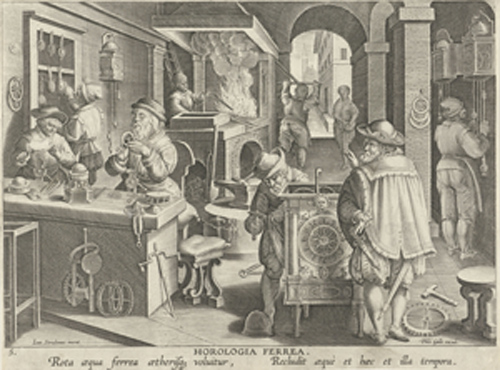
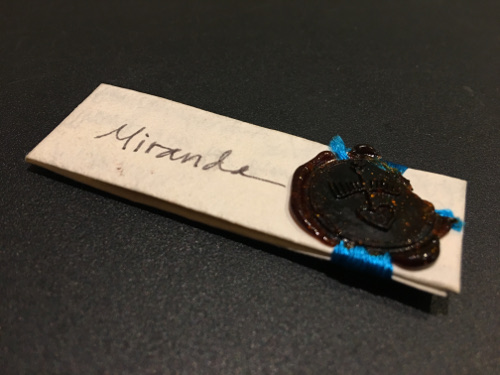
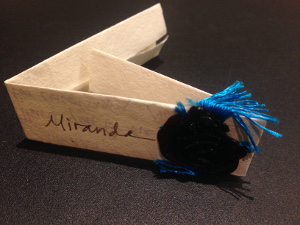 We were warned beforehand we would never look at a manuscript letter in the same way again, and the emails of thanks that have flooded in over the ensuing days confirmed this: ‘transfixing’; ‘absolutely bowled over’; ‘I will indeed see them so differently’; and ‘I can’t wait to visit the Reading Room again!’ If you wish to experience a little of letterlocking, it’s well worth setting aside time to watch
We were warned beforehand we would never look at a manuscript letter in the same way again, and the emails of thanks that have flooded in over the ensuing days confirmed this: ‘transfixing’; ‘absolutely bowled over’; ‘I will indeed see them so differently’; and ‘I can’t wait to visit the Reading Room again!’ If you wish to experience a little of letterlocking, it’s well worth setting aside time to watch 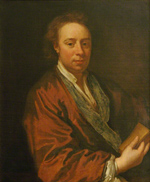
 walking pretty much as the crow flies) and his age (he was approaching sixty), and in part because his second wife, Susanna Reuttinger, was heavily pregnant (their youngest child, Anna Maria was born just one month later). Kepler wrote to ask Bernegger, who had helped introduce the couple, to deputize on his behalf, and Bernegger replied with accounts of the wedding. At this point, Kepler had only a few months left to live. Bernegger continued as professor and rector at Strasbourg for the final decade of his life, before dying there on 5 February 1640. Bartsch, the bridegroom at the Strasbourg wedding, edited and published his father-in-law’s Somnium, but is thought only to have lived for a further three years before succumbing to plague.
walking pretty much as the crow flies) and his age (he was approaching sixty), and in part because his second wife, Susanna Reuttinger, was heavily pregnant (their youngest child, Anna Maria was born just one month later). Kepler wrote to ask Bernegger, who had helped introduce the couple, to deputize on his behalf, and Bernegger replied with accounts of the wedding. At this point, Kepler had only a few months left to live. Bernegger continued as professor and rector at Strasbourg for the final decade of his life, before dying there on 5 February 1640. Bartsch, the bridegroom at the Strasbourg wedding, edited and published his father-in-law’s Somnium, but is thought only to have lived for a further three years before succumbing to plague.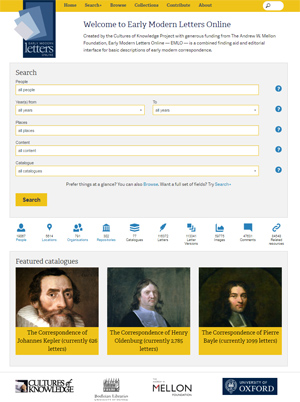 Of course eagle-eyed users will have spotted already significant new-year additions to existing catalogues in EMLO: as of this week, the calendar of
Of course eagle-eyed users will have spotted already significant new-year additions to existing catalogues in EMLO: as of this week, the calendar of 
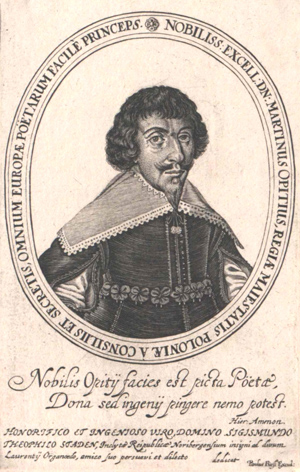
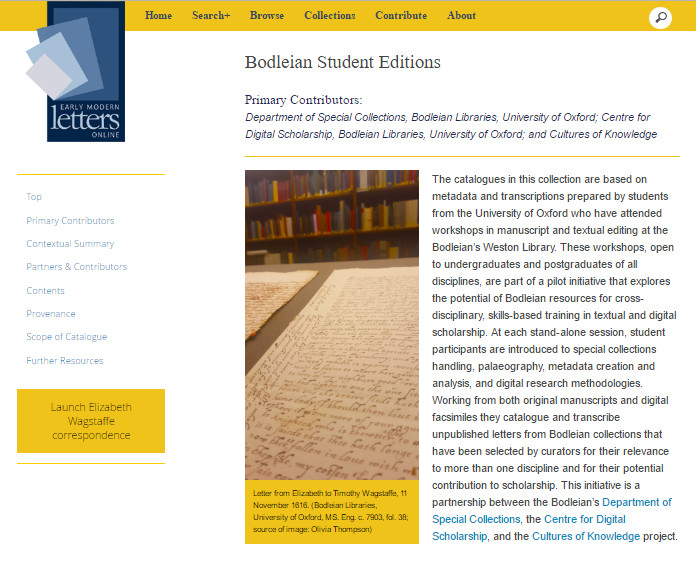 A collaboration between curatorial staff from the
A collaboration between curatorial staff from the 